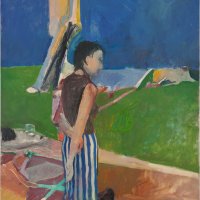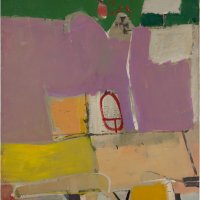*
When I was thirteen or fourteen I was friends with a boy, T, who lived across the road from me. We lived on a suburban estate that was being built around us – ours was the second house to go up, Thomas’ was the seventh, I think. For years we lived on or near a building site. And, as the leaves blew off the calendar, the developers bought up more and more land, and made a miniature sprawl of identikit houses (except that with each new road, the houses got smaller), from what had been muddy tracks and fields of hay. Bored teenagers, we used to ride around on our bikes, looking for amusement. One day, T decided it would be best if we broke every window in the developer’s office. Whoever it was that worked there, knocked off early in the afternoon. We waited until dusk to ride past and check it out. There was no one about, so we returned with stones, larger than our hands, picked from the beginnings of the Hook Pit Farm Lane part of the estate. T smashed the first few windows and asked me what I was waiting for. So, I smashed a few. It was meaningless and stupid and more fun than I expected.
While studying archictecture at Cornell University, Gordon Matta Clark (1943-1978) invented the concept of Anarchitecture. The name combines anarchy and architecture. In the Seventies, Matta Clark formed an artists’ group of the same name with Laurie Anderson, Tina Girouard, Carol Goodden, Suzanne Harris, Jene Highstein, Bernard Kirschenbaun, Richard Landry, and Richard Nonas. Their work critiqued the modernist impulses of contemporary late Sixties, early Seventies American culture, within which architecture was seen as a symbol for that culture’s worst excesses and drawbacks. Matta Clarke’s practice introduced new and radical modes of physically exploring and subverting urban architecture, and some of his most well-known projects involved laboriously cutting holes into floors of abandoned buildings or, as with Splitting (1974), slicing a suburban villa in two.
According to Floater Magazine, “In December 1976, Matta-Clark was invited by the Institute of Architecture to exhibit together with the New York Five in the show Idea as Model. His proposal was to place in every window casement of the Institute a photograph of some old or new building from the South Bronx of which the windows had been broken and vandalized. This way, he wanted to comment on vandalism as the social reality of many ‘ideal’ urban schemes. In order to avoid the pure aesthetisation of the project, he got the permission to break some of the windows of the Institute. But after a late party, he returned in the exhibition and shot holes in all of the windows of the building. The Institute was outraged. His action was one more expression of range against the architectural machine of development. The shooting aimed to mimic the despairing delinquency behind the endemic vandalism in the city.” I think he got a taste for it too.
*
*
Can Can Summer, Wolf Kidult Man and Is This New? are all tracks on The Fall’s 27th album, Imperial Wax Solvent (2008). It’s a lo-fi masterpiece. According to Wikipedia: “The album received some press attention when, due to a pressing error, the music of the album was recorded onto the first shipment of Faryl Smith’s debut album Faryl. The record label, Universal Classics and Jazz, was said to have “severe words” with the pressing plant. The incident attracted international attention. Whatever. You can listen to Taurig off the album here.
*
*
I’m basically the idea person. I’m not physically involved in the production. I don’t have the necessary abilities, so I go to the top people, whether I’m working with my foundry — Tallix — or in physics. I’m always trying to maintain the integrity of the work. I recently worked with Nobel prize winner Richard P. Feynman. I also worked with Wasserman at Dupont and Green at MIT. I worked with many of the top physicists and chemists in the country.
(extract from an interview with Jeff Koons, Journal of Contemporary Art, 1986)







ASBO’s v. Anarchitecture! A thought provoking post Richard on so many levels . . . art, and the purpose of, humanity and the sometimes weary robotic nature as I see it in your photos here and then there’s Jeff Koons, running all the way to the bank with it!
Ha, ha, fortunately for T and I there were no such things as ASBOs when we were young. Thanks very much, Patti! Yes, putting this together has made me want to read a lot more about Gordon Matta Clark.
And what is it with us? When I was a kid my friend and I waited until the construction crew had gone home then she kept an eye on the neighborhood by looking out the window while I drew on a beautiful new Sheetrock wall. It was fun.
Ha, ha, yes – your first mural!
Great post, Richard. Combining photographs with art in itself is inspiring, but the way you have supported that with two histories – you own and Matta-Clark’s – is nicely educational too! I may not condone the creativity, but it’s a great bit of work, Richard! 🙂
Thanks very much, Richard! 🙂
Ah ha! James Stewart has been visiting you too! This is a really cool window. I keep looking at the paper right up front on the picture plane , the transparent paint and then of course, the cars
Thanks very much, Carla. The paint’s watery acrylic and it’s slightly repelled by the matte paper, so it can easily not take. Fun to handle! I haven’t had a chance to watch Rear Window again, yet – this weekend for sure!
Beautiful fragments, Richard. I love how you have pieced them together.
Your layered/painted/collaged images are so wonderful too. I could imagine them printed huge on a translucent plexiglass and then back-lit.
Thanks so much, Karen. I really enjoyed putting this on together. And it’s years since I thought about scale – making them bigger is a really interesting idea.
Great images and stories. Me and my friends used to stuff like that as kids – the result of boredom, frustration and angst. Not something I’m particularly proud of, but that was just how it was.
Thanks very much, Stevie. Yes, I know what you mean – you’ve pretty much summed it up for me.
Really interesting post, I think most of us went through a similar phase although some never grow out of it
2nd image has to be my favourite of the three.
Thanks very much, Leon. Ha, ha, yes.
Yes, I think that’s mine too. I had a pretty clear idea of where I was going with that one.
Nicely collaged Richard, both literally and figuratively.
Thanks so much, Elena!
Hehe, anarchitecture 🙂 Great post!
Thanks very much, Cardinal! Matta Clark’s a fascinating figure – it’s a shame he died so young.
Awesome, Richard! Haven’t we all done stuff like that? My brother and I left some (very small) footprints in new concrete pavements in our time. We grew up in a socialist housing project that was being built around us. For a long time it rather looked like the surface of the moon and we were lectured in kindergarden and primary school not to climb on the sand and stone piles of the building sites, because you could get trapped in them due to pockets of air. I always imagined it like quicksand somehow …
Thanks very much, Lilly! That’s so sweet. We were shown films about the dangers of building sites, which cast them as sets from particularly grisly horror films. Of course, it made us all the more curious, ha ha.
Great post! And I love all your mixed media work so much! So creative!
Thanks very much, Ellen! I’m really glad you like it. They’re interesting to put together – I’ve not painted for a long while so I have to fight the urge to prettify.
Hi Richard, a very interesting piece about anarchy and architecture, I understand a bit more about your vision behind this set of photographs. They are quite captivating, I particularly like the first shot.
Hi Cheryl, thanks very much – this post came together easier than some – all the bits fed each other. I’m really glad you like the first shot – that was the last piece.
v. thought provoking, Richard. Enjoying the mixed media work. Nice to hear you were a bit of a rebel back in the day 🙂
Thanks very much, Emily. 🙂 Only a little one.
Reminds me very much of scenes in a movie. The protagonist comes into view. Society and the character are undergoing similar processes. Maybe vandalizing each other.
Very interesting take on it – thanks very much, Steven. I need to take my visual vandalism further.
Interesting mixed media post. Suburban estates or subdivisions, as we call them, divide opinion. They offer housing and security to some and suggest abomination, blight of landscape and settling to others. I’ve never cared for them, but they were a great real estate investment stepping stone, and to some they are truly home.
Thanks very much, EllaDee. Yes, I wouldn’t condemn suburbia for those qualities – the boredom has a galvanising effect for people who want to create something/ do something – I think of it as a kind of lab in some ways – you can experiment in relative safety.
Great work, great post.
Thanks very much, Deb – I really enjoy putting these together.
These are brilliant, Richard, are you going to do more of this stuff? Hope so. Ignore my last comment, just realised your title was This City, and not In The City.
Thanks very much, Alison. Yes, I am, but it takes time, as I’m kind of reacting to stuff and some images take a while to give me a jab. There have been a few failed attempts too – including working with a print that was really too big – the energy dispersed pretty quickly – it was like looking at Steve Lamaque’s voice. I liked it that you misread the title – I love The Jam. This City is the title of a John Foxx song.
Fascinating work!
Thanks very much, Jennifer!
Tried to comment here before but my computer was being a pig. This made me blush with recalling my own rebellious window breaking moment..and remembered the kind of (now guilty) rush of it too. Maybe I can all myself an Anarchitect now and feel better 🙂 Really liking your collages!
Yes, I’ve been having similar problems, recently. Ha, brilliant! Sorry to make you blush – it’s funny how many of us have done this. Yes, if we call it art, it’s OK. Thanks very much, Cath! I’m really glad you like them.
Ha Ha me too! Those clean white sheetrock walls – after the workmen went home – how could I resist ?? And how did my parents figure out the scribbles were done by me?